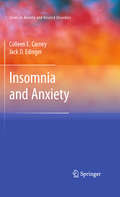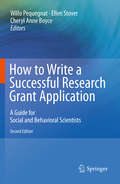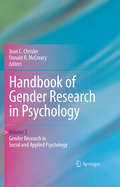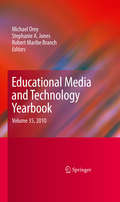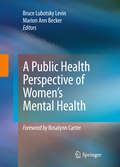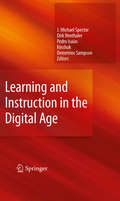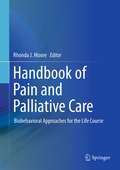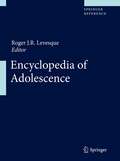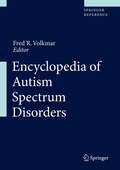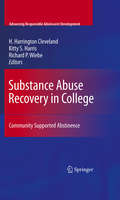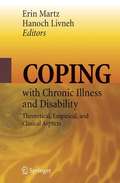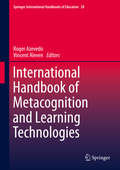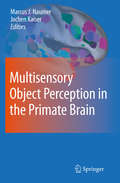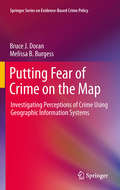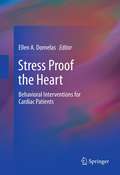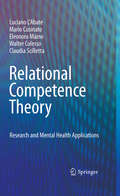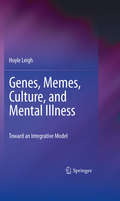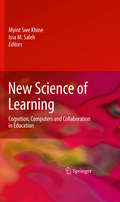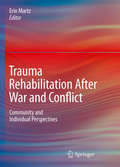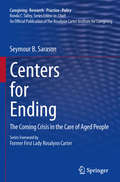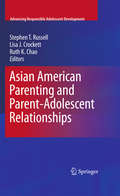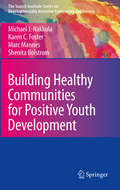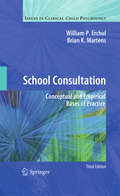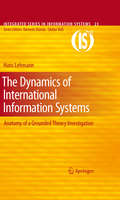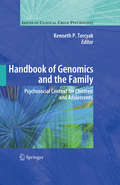- Table View
- List View
Insomnia and Anxiety
by Colleen E. Carney Jack D. EdingerThe statistics show that as much as twenty percent of the population suffers from chronic insomnia--and one-fourth of those with the condition eventually develop an anxiety disorder. As comorbid conditions, they contribute to any number of physical and social problems. Yet too often insomnia is undiagnosed, or treated as merely a symptom of the patient's anxiety. Insomnia and Anxiety is the first clinician guidebook that considers the evaluation and management of insomnia and related sleep disturbances that occur conjointly with the common anxiety disorders. By exploring the ways that one condition may exacerbate the other, its authors present robust evidence of the limitations of viewing insomnia as secondary to GAD, agoraphobia, PTSD, and others in the anxiety spectrum. The book reviews cognitive and emotional factors common to anxiety and sleep disorders, and models a cognitive-behavioral approach to therapy in which improved sleep is a foundation for improved symptom management. Beginning and veteran practitioners alike will find vital insights into all areas of these challenging cases, including: Diagnostic and assessment guidelines. Cognitive-behavior therapy for insomnia. Behavioral strategies for managing insomnia in the context of anxiety. Cognitive strategies for managing comorbid anxiety and insomnia. Sleep-related cognitive processes. Pharmacological treatment considerations. Insomnia and Anxiety is highly useful to clinical psychologists given the range of treatment strategies it describes and to researchers because of its emphasis on the theoretical and empirical bases for its interventions. In addition, its accessible style makes it an excellent training tool for students of therapy and psychopathology.
How to Write a Successful Research Grant Application
by Ellen Stover Cheryl Anne Boyce Willo PequegnatOver the last fifty years behavioral and medical research has been generously supported by the federal government, private foundations, and other philanthropic organizations contributing to the development of a vibrant public health system both in the United States and worldwide. However, these funds are dwindling and to stay competitive, investigators must understand the funding environment and know how to translate their hypotheses into research grant applications that reviewers evaluate as having scientific merit. The Second Edition of 'How to Write a Successful Research Grant Application' is the only book of its kind written by federal research investigators which provides technical assistance for researchers applying for biobehavioral and psychosocial research funding and can give them an edge in this competitive environment. The book provides invaluable tips on all aspects of the art of grantsmanship, including: how to determine research opportunities and priorities, how to develop the different elements of an application, how to negotiate the electronic submission and review processes, and how to disseminate the findings. Charts, visual aids, Web links, an extensive real-world example of a research proposal with budget, and a "So You Were Awarded Your Grant--Now What?" chapter show prospective applicants how to: - Formulate a testworthy--and interesting--hypothesis. - Select the appropriate research mechanism. - Avoid common pitfalls in proposal writing. - Develop an adequate control group. - Conduct a rigorous qualitative inquiry. - Develop a budget justification of costs. - Develop a human subjects of animal welfare plan. - Write a data analytic plan. - Design a quality control/assurance program. - Read between the lines of a summary of the review of your application. Although its focus is on Public Health Service funding, 'How to Write a Successful Research Grant' is equally useful for all research proposals, including graduate students preparing a thesis or dissertation proposal. Service providers in community-based organizations and public health agencies will also find this a useful resource in preparing a proposal to compete for grant funds from state and community resources, non-government organizations, and foundations.
Handbook of Gender Research in Psychology: Gender Research in Social and Applied Psychology
by Joan C. Chrisler Donald R. MccrearyRecent years have seen gender research achieve marked improvements in methods, terminology, and breadth of content. This handbook brings these achievements into perspective by presenting both the current state of the field and an ambitious future agenda.
Educational Media and Technology Yearbook, Volume 35
by Michael Orey Stephanie A. Jones Robert Maribe BranchThe evolution of educational technology has seen a shift from hardware and software to tactics and techniques, as the 2010 edition of the Educational Media and Technology Yearbook makes abundantly clear. As in previous years, it offers the reader a snapshot of the moment and a look ahead to issues most likely to shape the immediate future--an array as varied as the use of social networking sites in learning, new collaborations between media specialists and non-teaching school personnel, and the emerging discipline of Human Performance Technology. Here are ideas that are not only intellectually intriguing but also practical and practice-building, inspiring educators using computer technology to move beyond traditional teaching roles toward learning design. Included in the 2010 Yearbook: Salient issues in learning, design, and technology, such as the critical part school leadership plays in instructors' acceptance or rejection of technology, New trends in library and information science, including the role of school library media centers in preventing cyberbullying, This year's leadership profiles: Jerrold Kemp, author of Designing Effective Instruction; W. Michael Reed, accomplished, dedicated, and recognized educator in instructional technology, A worldwide directory of current professional associations and organizations in learning design, technology, information, and library science, Up-to-date listings of graduate program in these fields, rated using a variety of criteria, Special mediagraphy section featuring journals, ERIC documents, and media-related publications in specialized areas, including distance education, simulation/virtual reality, artificial intelligence, special education, and professional development. Academics in learning design and technology, and information and library science will welcome the latest edition of the Educational Media and Technology Yearbook as a reference, idea book, and a panoramic study of where we are now.
A Public Health Perspective of Women’s Mental Health
by Marion Ann Becker Bruce Lubotsky LevinA Public Health Perspective of Women's Mental Health Edited by Bruce Lubotsky Levin and Marion Ann Becker As many as one-half of all women in the U.S. will experience some form of mental illness in their lives--an especially distressing fact when health care budgets are in flux, adding to existing disparities and unmet health needs. Written from a unique multidisciplinary framework, A Public Health Perspective of Women's Mental Health addresses today's most pressing mental health challenges: effective treatment, efficient prevention, equal access, improved service delivery, and stronger public policy. Eminent clinicians, researchers, academicians, and advocates examine the effects of mental illness on women's lives and discuss the scope of clinical and service delivery issues affecting women, focusing on these major areas: Epidemiology of mental disorders in girls, female adolescents, adult women, and older women. Selected disorders of particular concern to women, including depression and postpartum depression, eating disorders, menopause, chemical dependence, and HIV/AIDS. Mental health needs of women in the workplace, rural areas, and prisons. Racial and ethnic disparities and their impact on service delivery. Parenting and recovery issues in mothers with mental illness. Women's mental health services in an era of evidence-based medicine. Improving women's health in today's technological climate. A Public Health Perspective of Women's Mental Health is a resource of immediate importance to professionals and graduate students in the public health, health administration, health disparities, social work, behavioral health, and health services research fields, as well as nursing, community/health psychology and community/public psychiatry.
Learning and Instruction in the Digital Age
by J. Michael SpectorInstruction tailored to the individual student, learning and teaching outside the limits of time and space--ideas that were once considered science fiction are now educational reality, with the prospect of an intelligent Web 3.0 not far distant. Alongside these innovations exists an emerging set of critical-thinking challenges, as Internet users create content and learners (and teachers) take increased responsibility in their work. Learning and Instruction in the Digital Age nimbly balances the technological and pedagogical aspects of these rapid changes, gathering papers from noted researchers on a wealth of topics relating to cognitive approaches to learning and teaching, mental models, online learning, communications, and innovative educational technologies, among them: Cognition and student-centered, Web-based learning, The progression of mental models throughout a course of instruction, Experiencing education with 3D virtual worlds, Expanding educational boundaries through multi-school collaboration, Adapting e-learning to different learning styles, The student blog as reflective diary. With its blend of timely ideas and forward thinking, Learning and Instruction in the Digital Age will enrich the work of researchers in educational psychology, educational technology, and cognitive science.
Handbook of Pain and Palliative Care
by Rhonda J. MooreHandbook of Pain and Palliative Care:Biobehavioral Approaches for the Life Course Rhonda J. Moore, editor This book takes both a biobehavioral and a lifespan approach to understanding long-term and chronic pain, and intervening to optimize patients' functioning. Rich in clinical diversity, chapters explore emerging areas of interest (computer-based interventions, fibromyalgia, stress), ongoing concerns (cancer pain, low back pain), and special populations (pediatric, elderly, military). This coverage provides readers with a knowledge base in assessment, treatment, and management that is up to date, practice strengthening, and forward looking. Subject areas featured in the Handbook include: Patient-practitioner communication Assessment tools and strategies Common pain conditions across the lifespan Biobehavioral mechanisms of chronic pain Pharmaceutical, neurological, and rehabilitative interventions Psychosocial, complementary/alternative, narrative, and spiritual approaches Ethical issue and future directions With the rise of integrative perspective and the emphasis on overall quality of life rather than discrete symptoms, pain management is gaining importance across medical disciplines. Handbook of Pain and Palliative Care stands out as a one-stop reference for a range of professionals, including health practitioners specializing in pain management or palliative care, clinical and health psychologists, public health professionals, and clinicians and administrators in long-term care and hospice.usculoskeletal pain. Finally, the text discusses broader issues in chronic pain management, including psychosocial issues associated with chronic pain, spiritual dimensions of chronic pain and suffering, contributions from the humanities and social sciences in terms of understanding the chronic pain experience, and highlights ethical issues in pain and palliative care. The collaborators for this project are from diverse cultural and biomedical settings, including the United Kingdom, United States, Italy, England, Singapore, Canada, Australia, and Norway. The expertise in this volume span the fields of clinical medicine, neuroscience, neurosurgery, literature, anthropology, art, neuroanatomy, pediatrics, gerontology, pain imaging, health disparities, transportation, rehabilitation, palliative medicine, philanthropy, the medical humanities, oncology, physiology, anesthesiology, pharmacology, genetics, stress management, psychology, dentistry, complementary and alternative medicine, spiritual care, nursing, pain policy, and clinical ethics. Whilst highly multidisciplinary, authors explore the evidence base for chronic pain and palliative care in their individual professional areas and each has provided valuable insights with the hope that it will result in improved pain control and palliative care.
Encyclopedia of Adolescence
by Roger J.R. LevesqueThe Encyclopedia of Adolescence breaks new ground as an important central resource for the study of adolescence. Comprehensive in breath and textbook in depth, the Encyclopedia of Adolescence - with entries presented in easy-to-access A to Z format - serves as a reference repository of knowledge in the field as well as a frequently updated conduit of new knowledge long before such information trickles down from research to standard textbooks. By making full use of Springer's print and online flexibility, the Encyclopedia is at the forefront of efforts to advance the field by pushing and creating new boundaries and areas of study that further our understanding of adolescents and their place in society. Substantively, the Encyclopedia draws from four major areas of research relating to adolescence. The first broad area includes research relating to "Self, Identity and Development in Adolescence". This area covers research relating to identity, from early adolescence through emerging adulthood; basic aspects of development (e.g., biological, cognitive, social); and foundational developmental theories. In addition, this area focuses on various types of identity: gender, sexual, civic, moral, political, racial, spiritual, religious, and so forth. The second broad area centers on "Adolescents' Social and Personal Relationships". This area of research examines the nature and influence of a variety of important relationships, including family, peer, friends, sexual and romantic as well as significant nonparental adults. The third area examines "Adolescents in Social Institutions". This area of research centers on the influence and nature of important institutions that serve as the socializing contexts for adolescents. These major institutions include schools, religious groups, justice systems, medical fields, cultural contexts, media, legal systems, economic structures, and youth organizations. "Adolescent Mental Health" constitutes the last major area of research. This broad area of research focuses on the wide variety of human thoughts, actions, and behaviors relating to mental health, from psychopathology to thriving. Major topic examples include deviance, violence, crime, pathology (DSM), normalcy, risk, victimization, disabilities, flow, and positive youth development.
Encyclopedia of Autism Spectrum Disorders
by Fred R. VolkmarThis major reference work breaks new ground as an electronic resource for students, educators, researchers, and professionals. Comprehensive in breath and textbook in depth, the Encyclopedia of Autism Spectrum Disorders serves as a reference repository of knowledge in the field as well as a regularly updated conduit of new knowledge long before such information trickles down from research to standard textbooks. The Encyclopedia consists of 5 volumes and approximately 1,500 entries divided by the major conceptual areas of ASD and PDDs, including: - Research trends and findings - Behavior/speech - Communication - Treatments - Education Taking advantage of the techniques offered by the electronic medium, the Encyclopedia of Autism Spectrum Disorders offers an extensive cross-referencing system facilitating search and retrieval of information.
Substance Abuse Recovery in College
by Kitty S. Harris Richard P. Wiebe H. Harrington ClevelandSubstance Abuse Recovery in College explains in authoritative detail what collegiate recovery communities are, the types of services they provide, and their role in the context of campus life, with extended examples from Texas Tech University's influential CSAR (Center for the Study of Addiction and Recovery) program. Using data from both conventional surveys and end-of-day daily Palm Pilot assessments as well as focus groups, the book examines community members' experiences. In addition, the importance of a positive relationship between the recovery community and the school administration is emphasized. Topics covered include: The growing need for recovery services at colleges. How recovery communities support abstinence and relapse prevention. Who are community members and their addiction and treatment histories. Daily lives of young adults in a collegiate recovery community. Challenges and opportunities in establishing recovery communities on campus. Building abstinence support into an academic curriculum. This volume offers clear insights and up-close perspectives of importance to developmental and clinical child psychologists, social workers, higher education policymakers, and related professionals in human development, family studies, student services, college health care, and community services.
Coping With Chronic Illness And Disability: Theoretical, Empirical, And Clinical Aspects
by Hanoch Livneh Erin MartzThis book synthesizes the expanding literature on coping styles and strategies by analyzing how individuals with CID face challenges, find and use their strengths, and alter their environment to fit their life-changing realities. The book includes up-to-date information on coping with high-profile conditions, such as cancer, heart disease, diabetes, arthritis, spinal cord injuries, and traumatic brain injury, in-depth coverage of HIV/AIDS, chronic pain, and severe mental illness, and more.
International Handbook of Metacognition and Learning Technologies
by Vincent Aleven Roger AzevedoIntegrating all aspects of the fields of metacognition and learning technologies, this book describes features of the learning technologies and how they have been designed to study and support metacognitive processing and self-regulated learning.
Multisensory Object Perception in the Primate Brain
by Marcus Johannes Naumer Jochen KaiserTraditionally, a large proportion of perceptual research has assumed a specialization of cortical regions for the processing of stimuli in a single sensory modality. Perception in everyday life, however, usually consists of inputs from multiple sensory channels. Recently the question of how the brain integrates multisensory information has become the focus of a growing number of neuroscientific investigations. This work has identified both multisensory integration regions and crossmodal influences in brain areas traditionally thought to be specific to one sensory modality. Furthermore, several factors have been identified that enhance integration such as spatio-temporal stimulus coincidence and semantic congruency. Multisensory Object Perception in the Primate Brain elucidates the mechanisms of multisensory integration of object-related information with a focus on the visual, auditory, and tactile sensory modalities. Evidence is presented in four sections: methodological considerations, audio-visual processing, visuo-tactile processing, and plasticity, and includes studies in both human and nonhuman primates at different levels of analysis. Studies range from intracranial electrophysiological recordings to non-invasive electro- or magnetoencephalography, functional magnetic resonance imaging, behavioral approaches, and computational modeling.
Putting Fear of Crime on the Map
by Melissa B. Burgess Bruce J. DoranSince first emerging as an issue of concern in the late 1960s, fear of crime has become one of the most researched topics in contemporary criminology and receives considerable attention in a range of other disciplines including social ecology, social psychology and geography. Researchers looking the subject have consistently uncovered alarming characteristics, primarily relating to the behavioural responses that people adopt in relation to their fear of crime. This book reports on research conducted over the past eight years, in which efforts have been made to pioneer the combination of techniques from behavioural geography with Geographic Information Systems (GIS) in order to map the fear of crime. The first part of the book outlines the history of research into fear of crime, with an emphasis on the many approaches that have been used to investigate the problem and the need for a spatially-explicit approach. The second part provides a technical break down of the GIS-based techniques used to map fear of crime and summarises key findings from two separate study sites. The authors describe collective avoidance behaviour in relation to disorder decline models such as the Broken Windows Thesis, the potential to integrate fear mapping with police-community partnerships and emerging avenues for further research. Issues discussed include fear of crime in relation to housing prices and disorder, the use of fear mapping as a means with which to monitor the impact of Closed Circuit Television (CCTV) and fear mapping in transit environments.
Stress Proof the Heart: Behavioral Interventions for Cardiac Patients
by Ellen A. DornelasCardiovascular disease is a leading cause of death throughout the world. Chronic negative emotions such as depression and anxiety place cardiac patients at greater risk for death and recurrence of cardiovascular disease. In 2008 the editor published a book related to this topic, titled Psychotherapy with Cardiac Patients: Behavioral Cardiology in Practice (American Psychological Association). Aside from that book, there are very few resources specifically written for clinicians who treat psychologically distressed cardiac patients. Unlike other medical specialty areas such as oncology, the field of cardiology has been slow to integrate behavioral treatments into the delivery of service. Perhaps because the field has been largely defined and dominated by researchers, mental health clinicians are only starting to recognize behavioral cardiology as a viable arena in which to practice. There is a large void in the practitioner literature on behavioral cardiology. In a review of Psychotherapy with Cardiac Patients, Paul Efthim, Ph.D. wrote, "Her new book goes well beyond previous works by giving specific and detailed guidance about how to tailor psychological interventions with this variegated population." He added, "It would benefit from even more details about treatment approaches." This proposed volume goes beyond the editor's previous volume by providing in-depth descriptions of behavioral treatments for distressed cardiac patients written by eminent leaders in behavioral cardiology. This book describes a wide range of behavioral treatments for the common psychologically based problems encountered by clinicians who treat cardiac patients. The book is organized as follows: Part I focuses on the most psychologically challenging and common presentations of cardiac diagnosis; coronary artery disease, arrhythmia, and heart failure. This section also includes a chapter on heart transplantation, which is a treatment, not a diagnosis, but a treatment that incurs profound psychological impact for the individual. In Part II, behavioral interventions for the general cardiac population are described. Mainstream therapies such as stress management, cognitive-behavioral therapy, and medical family therapy are described, along with approaches that have less empirical support but considerable practical significance such as personality-guided therapy and interventions aimed at altering type D personality traits. The literature in behavioral cardiology has a rich history of investigating maladaptive personality traits and thus it is important to include behavioral approaches that target personality in this volume. Part III focuses on common behavioral problems encountered by clinicians who work with this patient population. Most patients who seek psychological help do so because they perceive themselves to be stressed due to their job or overextended in all areas of their life. Other people with heart disease present with sleep problems and/or an inability to motivate themselves to exercise or quit smoking. There are many practical behavioral approaches that can be helpful for patients with these difficulties and these are detailed in this section of the book. The conclusion of the book focuses on how to integrate the behavioral treatments described in the preceding chapters into a comprehensive treatment model.
Relational Competence Theory
by Luciano L'Abate Claudia Scilletta Mario Cusinato Walter Colesso Eleonora MainoRelational competence--the set of traits that allow people to interact with each other effectively--enjoys a long history of being recorded, studied, and analyzed. Accordingly, Relational Competence Theory (RCT) complements theories that treat individuals' personality and functioning individually by placing the individual into full family and social context. The ambitious volume Relational Competence Theory: Research and Mental Health Applications opens out the RCT literature with emphasis on its applicability to interventions, and updates the state of research on RCT, examining what is robust and verifiable both in the lab and the clinic. The authors begin with the conceptual and empirical bases for the theory, and sixteen models demonstrate the range of RCT concerns and their clinical relevance, including: - Socialization settings for relational competence. - The ability to control and regulate the self. - Relationship styles. - Intimacy and negotiation. - The use of practice exercises in prevention and treatment of pathology. - Appendices featuring the Relational Answers Questionnaire and other helpful tools. Relational Competence Theory both challenges and confirms much of what we know about the range of human relationships, and is important reading for researchers, scholars, and students in personality and social psychology, psychotherapy, and couple and family counseling.
Genes, Memes, Culture, and Mental Illness
by Hoyle LeighWhat produces mental illness: genes, environment, both,neither? The answer can be found in memes--replicable units of information linking genes and environment in the memory and in culture--whose effects on individual brain development can be benign or toxic. This book reconceptualizes mental disorders as products of stressful gene-meme interactions and introduces a biopsychosocial template for meme-based diagnosis and treatment. A range of therapeutic modalities, both broad-spectrum (meditation) and specific(cognitive-behavioral), for countering negative memes and their replication are considered, as are possibilities for memetic prevention strategies. In this book, the author outlines the roles of genes and memes in the evolution of the human brain; elucidates the creation, storage, and evolution of memes within individual brains; examines culture as a carrier and supplier of memes to the individual; provides examples of gene-meme interactions that can result in anxiety, depression, and other disorders; proposes a multiaxial gene-meme model for diagnosing mental illness; identifies areas of meme-based prevention for at-risk children; and defines specific syndromes in terms of memetic symptoms, genetic/ memetic development, and meme-based treatment.
New Science of Learning
by Myint Swe Khine Issa M. SalehThe earliest educational software simply transferred print material from the page to the monitor. Since then, the Internet and other digital media have brought students an ever-expanding, low-cost knowledge base and the opportunity to interact with minds around the globe--while running the risk of shortening their attention spans, isolating them from interpersonal contact, and subjecting them to information overload. The New Science of Learning: Cognition, Computers and Collaboration in Education deftly explores the multiple relationships found among these critical elements in students' increasingly complex and multi-paced educational experience. Starting with instructors' insights into the cognitive effects of digital media--a diverse range of viewpoints with little consensus--this cutting-edge resource acknowledges the double-edged potential inherent in computer-based education and its role in shaping students' thinking capabilities. Accordingly, the emphasis is on strategies that maximize the strengths and compensate for the negative aspects of digital learning, including: Group cognition as a foundation for learning Metacognitive control of learning and remembering Higher education course development using open education resources Designing a technology-oriented teacher professional development model Supporting student collaboration with digital video tools Teaching and learning through social annotation practices The New Science of Learning: Cognition, Computers and Collaboration in Education brings emerging challenges and innovative ideas into sharp focus for researchers in educational psychology, instructional design, education technologies, and the learning sciences.
Trauma Rehabilitation After War and Conflict
by Erin Martz"As foreign assistance flows into post-conflict regions to rebuild economies, roads, and schools, it is important that development professionals retain a focus on the purely human element of rebuilding lives and societies. This book provides perspective on just how to begin that process so that the trauma people suffered is not passed on to future generations long after the violence has stopped." - Amy T. Wilson, Ph.D., Gallaudet University, Washington, DC "This ground-breaking text provides the reader with an excellent and comprehensive overview of the existing field of trauma rehabilitation. It also masterfully navigates the intricate relationships among theory, research, and practice leaving the reader with immense appreciation for its subject matter." - Hanoch Livneh, Hanoch Livneh, Ph.D., LPC, CRC, Portland State University Fear, terror, helplessness, rage: for soldier and civilian alike, the psychological costs of war are staggering. And for those traumatized by chronic armed conflict, healing, recovery, and closure can seem like impossible goals. Demonstrating wide-ranging knowledge of the vulnerabilities and resilience of war survivors, the collaborators on Trauma Rehabilitation after War and Conflict analyze successful rehabilitative processes and intervention programs in conflict-affected areas of the world. Its dual focus on individual and community healing builds on the concept of the protective "trauma membrane," a component crucial to coping and healing, to humanitarian efforts (though one which is often passed over in favor of rebuilding infrastructure), and to promoting and sustaining peace. The book's multiple perspectives--including public health, community-based systems, and trauma-focused approaches--reflect the complex psychological, social, and emotional stresses faced by survivors, to provide authoritative information on salient topics such as: Psychological rehabilitation of U.S. veterans, non-Western ex-combatants, and civilians Forgiveness and social reconciliation after armed conflict Psychosocial adjustment in the post-war setting Helping individuals heal from war-related rape The psychological impact on prisoners of war Rehabilitating the child soldier Rehabilitation after War and Conflict lucidly sets out the terms for the next stage of humanitarian work, making it essential reading for researchers and professionals in psychology, social work, rehabilitation, counseling, and public health.
Centers for Ending: The Coming Crisis in the Care of Aged People (Caregiving: Research • Practice • Policy)
by Seymour B. SarasonAs people live longer and health care costs continue to rise and fewer doctors choose to specialize in geriatrics, how prepared is the United States to care for its sick and elderly? According to veteran psychologist Seymour Sarason's eloquent and compelling new book, the answer is: inadequately at best. And rarely discussed among the grim statistics is the psychosocial price paid by nursing home patients, from loneliness and isolation to depression and dependency. In Centers for Ending, Dr. Sarason uses his firsthand experience as both practitioner and patient in senior facilities to reveal wide-ranging professional and moral issues affecting this seemingly familiar terrain. Insensitive medical personnel, poorly trained nurses and aides, indifferent administrators, and a prevailing culture content with treating "bodies" instead of human beings are identified as contributing factors. Drawing on America's rich history of large-scale solutions to social problems, Dr. Sarason offers penetrating insights and bold suggestions in such areas as: The widening care gap between haves and have-nots.Why professional caregivers fail to understand patients.The nursing home resident as immigrant.Why previous reform efforts have not worked.The need for a Presidential commission for the elderly.The scenario if conditions are allowed to remain as they are or worsen. This concise volume is essential reading for researchers, graduate students, professionals, practitioners, and policy makers across such fields as geriatric medicine, health psychology, social work, public health, and public policy. Centers for Ending is a clarion call to be ignored at great cost to our elders and ourselves.
Asian American Parenting and Parent-Adolescent Relationships (Advancing Responsible Adolescent Development)
by Stephen T. Russell Ruth K. Chao Lisa J. CrockettThe growing presence of non-European cultures in America brings new challenges to as well as opportunities for parenting research. Whereas particular constructs of parent-child relationships were once considered universal, we now recognize distinct cultural variations. This is especially true in the case of Asian Americans, a population encompassing many diverse ethnicities. Informed by a variety of qualitative and quantitative methodologies including detailed surveys of teenagers and their parents, Asian American Parenting and Parent-Adolescent Relationships focuses on Chinese and Filipino Americans--large populations with markedly different histories and cultural influences--giving readers a new lens into the nature and meaning of cultural differences in parenting. Synthesizing data on adolescent autonomy and dependence, parental support and control (both crucial to adolescents' wellbeing), and the rarely-explored concept of parental sacrifice, this ambitious volume: Compares the parental belief systems of European Americans and immigrant Chinese and their influence on parenting styles. Discusses the role of measurement equivalence in understanding Asian American parenting practices. Examines sacrifice as a central concept in Asian American parenting and in immigrant parenting in general. Analyzes how Asian American teenagers understand the support and control provided by their parents. Explores the dynamics of parent and child gender in Asian American parenting. Places these findings in the context of previous parenting research and identifies new directions for the field. Asian American Parenting and Parent-Adolescent Relationships is a uniquely informative reference for researchers, clinicians, and graduate students across multiple disciplines, including developmental, clinical child, and school psychology, sociology, and anthropology as well as ethnic and women's studies. "A much needed and extremely thoughtful contribution to the scholarship on Asian American families. The authors rely on a variety of research methods to reveal patterns that challenge stereotypes and urge us to move beyond pan ethnic categories and explore the rich diversity among Asian Americans. This book is an exemplary study of culture and parenting." (Niobe Way, President, Society for Research on Adolescence / Professor of Applied Psychology, New York University)
Building Healthy Communities for Positive Youth Development (The Search Institute Series on Developmentally Attentive Community and Society #7)
by Michael J. Nakkula Shenita Bolstrom Marc Mannes Karen C. FosterThe Healthy Communities Healthy Youth (HC HY) project has provided grassroots support for the creation of robust, welcoming environments not only for children and adolescents at risk but for all youth. Building Healthy Communities for Positive Youth Development explains the Developmental Assets framework in depth and demonstrates how eight local initiatives across the country have adapted and implemented it to fit the unique cultures and resources of their neighborhoods and the needs and strengths of their young people. Stakeholders collaborating in the process include parents, educators, politicians, service providers, law enforcement, volunteers, and?as active participants instead of merely recipients of services?youth themselves. In this visionary book, the authors provide readers with a flexible, living blueprint for promoting the well-being of children and teenagers. Areas of coverage include: Core themes of the eight HC HY initiatives. The use of an asset-based common language among participants. Building common ground among the various sectors involved in the initiatives. The varied roles of young people within the initiatives. Research design and methodology; data collection and interpretation. Funding issues and challenges. The mission outlined in Building Healthy Communities for Positive Youth Development fits the interests of a wide range of professionals, including developmental psychologists; child, youth, and family service professionals; clinical child and school psychologists; and allied education and mental health practitioners working with children and adolescents.
School Consultation
by Brian K. Martens William P. ErchulSince its emergence during the 1960s, school consultation has become an important vehicle for delivering psychological and educational services. Cooperative efforts between skilled consultants and teachers, rooted in the principles of problem solving, social influence, and professional development, enhance student learning and adjustment while encouraging consultees to be more effective and proactive in their practice. The Third Edition of School Consultation: Conceptual and Empirical Bases of Practice shows in expert detail how this relationship works by synthesizing mental health and behavioral models of consultation with the most effective evidence-based practices (e.g., implementation support, response to intervention) informing the field today. The authors provide real-world contexts for all participants in the equation--consultants, teachers, students, staff, and the school itself--and thoroughly review consultation processes and outcomes for a contemporary practice-oriented approach suited to the new consultant, trainee, or researcher. Key features of the Third Edition include: An integrated mental health/behavioral model for school consultation.An organizational study of the school as a setting for consultation.Assessment issues and strategies particularly relevant to school consultation.Approaches to providing teachers with implementation support. Conceptual models for selecting academic and behavioral interventions.Administrative perspectives on school consultation.A real, transcribed case study analyzed by the authors.In the tradition of its predecessors, School Consultation, Third Edition, is a confidence-building tool for practitioners in school psychology, clinical child psychology, educational specialties, school counseling, special education, and school social work as well as a trusted reference for researchers in these fields.
The Dynamics of International Information Systems
by Hans LehmannWith this new monograph, Hans Lehmann demonstrates the efficacy of using the Grounded Theory method to study the factors that lead to success - or failure - in the creation and ongoing management of the international information systems (IIS) within global enterprises. He presents three cases of large transnational companies he worked with in this study and describes in detail the steps in the analysis of findings and the incremental conceptualization that finally result in a substantive theory of IIS. There is also a companion website that contains a full set of analysis notes to add a further level of detail. Grounded Theory was developed in the social sciences as a means of recording, analyzing, understanding and then fully explaining what was happening within a given social situation - so that theories could be developed that were firmly grounded in those circumstantial facts. The method is very well-suited to solving information systems problems in any enterprise setting, let alone in those situations peculiar to multi-national enterprises.
Handbook of Genomics and the Family
by Kenneth P. TercyakToday's consumer can send a company a DNA sample and receive a detailed set of genetic test results in return all without ever visiting a health care provider. Although knowing one's personal risk for serious disease may lead some individuals to make more informed health choices, an ever-growing set of questions remains: Are predictive genetic tests meaningful? Can the results be harmful as well as helpful? In what ways can genetic information be used by health care providers to predict disease risk and optimize medical management within concerned families? Most important, how might the landscape of genetic testing affect the care of children's health? Although there are no easy answers, the Handbook of Genomics and the Family details in one authoritative volume the challenges entailed by the latest genetic advances and offers insights into the potential translation of this knowledge in pediatric and family practice and public health. This timely and comprehensive reference introduces readers to the study of how genes, singly and in combination with each other and the environment, affect health and behavior; summarizes current findings on genetics and genomics in disease etiology and prevention; and provides family-focused perspectives relating to genetic counseling and education. Key features of the Handbook include: - In-depth background in genetics and genomics in relationship to disease etiology and epidemiology. - Integrative frameworks for understanding genetics and genomics in the context of families. - Considerations for communicating genetic and genomic information. - Individual chapters on genetic and familial risks for specific diseases and conditions, including cancer, obesity, and Type 1 diabetes among children and adolescents. - Training, ethics, and other emerging issues and controversies. - Contemporary policies on genetic testing in children and families. The Handbook of Genomics and the Family is essential reading for clinical child and pediatric psychologists and psychiatrists, pediatricians and nurses, clinical geneticists and genetic counselors, and public health specialists as advances in genetics lead the way to more personalized models of health.
